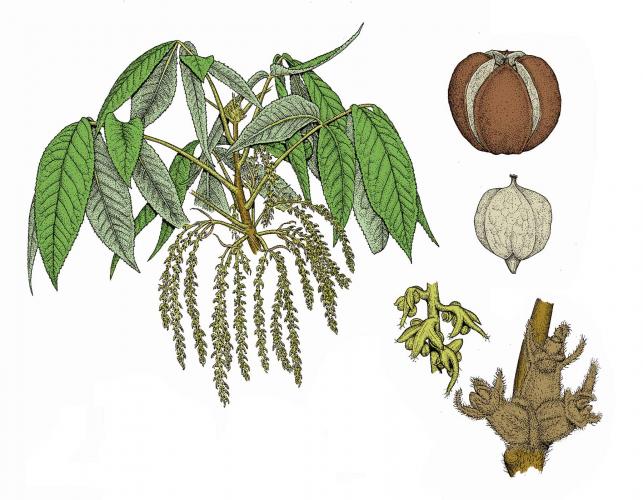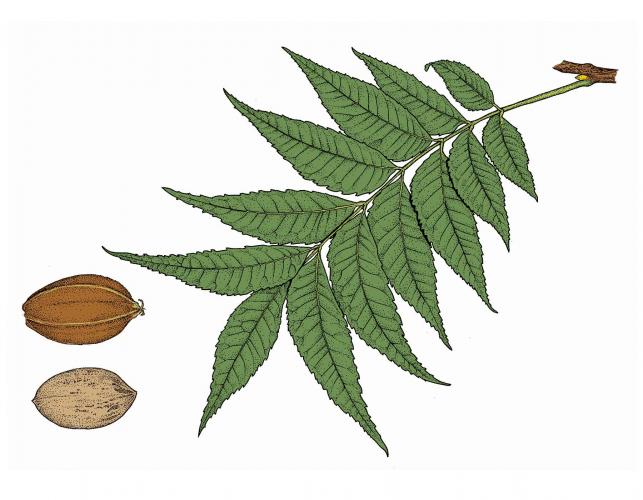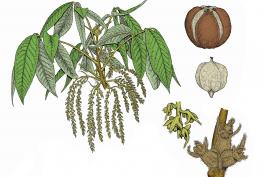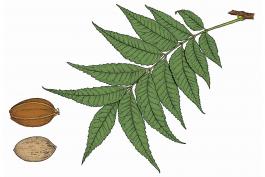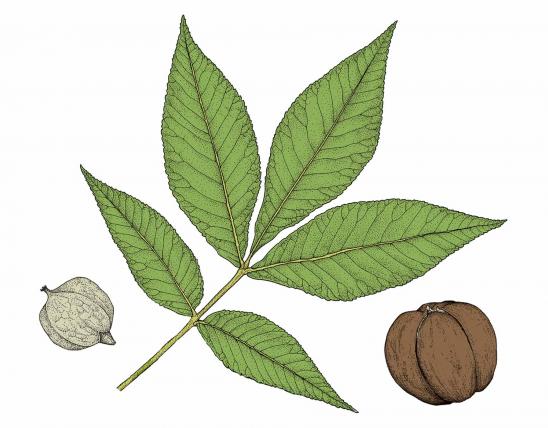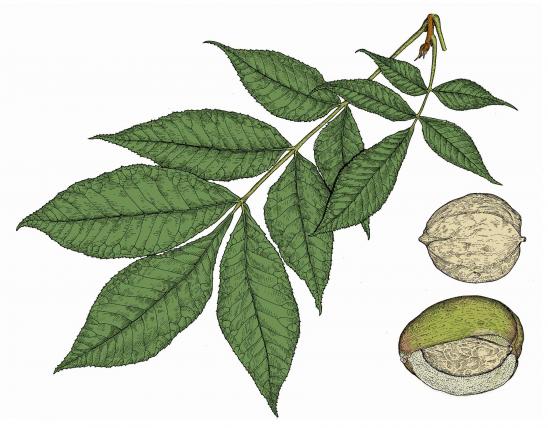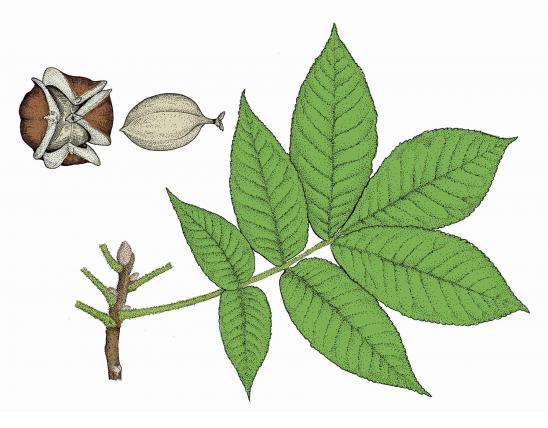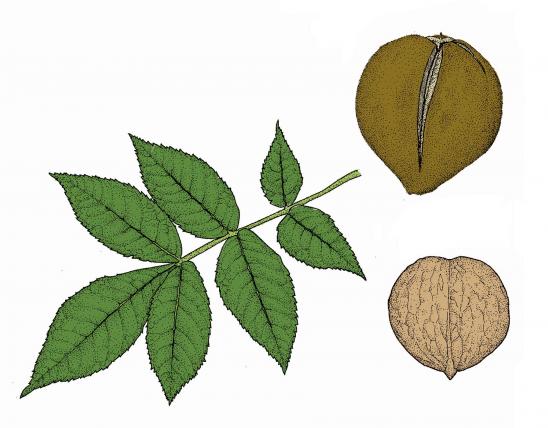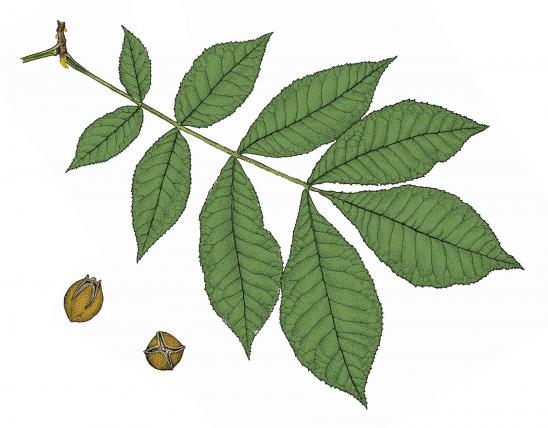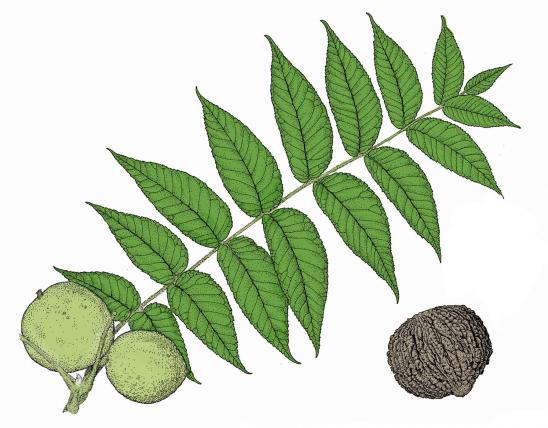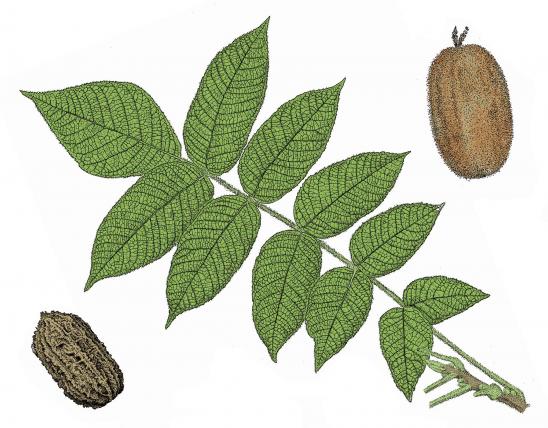
Hickories are trees in the genus Carya. There are 9 species that grow naturally in Missouri. All have alternate, feather-compound leaves with 5–13 unlobed leaflets per leaf. The largest leaflets are often near the leaf tip, though in some species they are uniform or have the middle leaflets larger. In nearly all our species, the leaflet margins are toothed. Hickory leaves typically turn golden yellow in the fall.
Male flowers and female flowers arise from different structures on the same tree. Male flowers occur on cylindrical drooping clusters (catkins). These are usually 3-branched with several catkins appearing at the base of the current season's growth. The female flowers are relatively few and inconspicuous, appearing near the tip of the new growth. They are fertilized when wind blows pollen to them from the male flowers. All our hickories bloom April–May.
Hickory fruits have the husk split lengthwise for at least half of the fruit length, releasing the nut. The nuts often have 4 lengthwise ridges; otherwise, the nut’s outer surface is hard (bony) and either smooth or shallowly wrinkled. All our hickories produce fruits September–October.
Twigs have the pith solid and homogeneous (not chambered).
Bark varies. Shagbark, shellbark, and water hickory have “shaggy” bark that peels away from the trunk in long, thin strips. The other species do not have shaggy bark.
Two Groups of Hickories
Hickories are divided into two major groups: the pecan hickories and the true hickories:
- True hickories (section Carya) have mostly 5–7 leaflets, and there is a large egg-shaped bud at the end of each twig; the bud scales overlap strongly. Missouri's species in this group are shagbark, shellbark, mockernut, pignut, black, and sand hickory.
- Pecan hickories (section Apocarya) have more than 7 sickle-shaped leaflets, and the terminal bud is elongated and flattened; the bud scales do not overlap. Missouri's species in this group include pecan, bitternut, and water hickory.
True Hickories
- Black hickory (Ozark pignut hickory) (C. texana): the nut of this hickory, like that of the pignut hickory, is awfully hard to crack. Because rural Ozarkers noticed their hogs had no trouble extracting the sweet kernels, both species came to be called “pignut hickories.” Black hickory is distinguished from pignut hickory by 7 (not 5) leaflets; tapering twigs; and young twigs and terminal buds that have fuzzy, rusty scales with tiny yellow dots. Black hickory is widespread south of the Missouri River, typically in acidic soils with low fertility.
- Mockernut hickory (C. tomentosa) stands out from the rest for its hard wood, thick-shelled fruit enclosing relatively small kernels, large and light-colored terminal buds, and tight, never shaggy, bark. It occurs nearly statewide, except for the far southeast corner and our northwestern counties. It is most common in the southern half of the state. It usually occurs in dry, upland areas, in acidic soils, and sometimes also in low woods along streams.
- Pignut hickory (C. glabra) is a rugged tree of dry upland forests in the eastern Ozarks. It has pear-shaped fruits with thin husks. Settlers were unimpressed with the nuts’ flavor and fed them to their hogs. It occurs mostly in the eastern Ozarks but can be found scattered throughout southern Missouri and in a few counties just north of the Missouri River. It is usually found in dry upland woods, usually in acid soils, especially in the Ozarks, but also in sandy or gravelly soils of dry upland wooded ridges in southeastern Missouri’s Crowley’s Ridge.
- Sand hickory (C. pallida) occurs only in the Bootheel, on sandy or gravelly soils in upland areas (sand prairies, sand savannas, and less commonly in upland forests). It’s uncommon in our state and is known only from Scott and Stoddard counties; its center of population is in states to our southeast. The undersurface of the leaflets has many large, round, silvery-gray scales; the leaf stem and midvein are sparsely to densely hairy (always densely hairy near the leaflet bases).
- Shagbark hickory (C. ovata) has tough wood, distinctive shaggy bark, and large, sweet, easy-to-crack nuts. It grows nearly statewide and is the most common hickory north of the Missouri River. It occurs in bottomland forests in valleys along streams and in upland forests on slopes and ridges.
- Shellbark hickory (big shagbark hickory; kingnut) (C. lacinosa) is the largest of the true hickories and has the best-tasting hickory nuts in Missouri. It has shaggy bark, but compared to shagbark hickory, it has larger leaves and more leaflets, plus larger nuts and orange twigs. It grows scattered widely throughout the state but is absent from much of the Ozark division. It is found in the fertile bottomland soils of valleys along streams and in river floodplains, usually in partial sun. This species is becoming scarce because the rich, deep river bottom soils it grows in have been cleared to grow crops.
Pecan Hickories
- Bitternut hickory (C. cordiformis) is our only hickory with long, bright yellow buds. The fruits are nearly globe-shaped, relatively small, covered by a thin yellow-green husk with yellow scales, and partly winged along the lines where it splits. The nut tip is sharp. The common name refers to the bitter taste of the nut — but the flavor doesn't put off squirrels, mice, and deer. It is common statewide, usually in low, moist woods near streams.
- Pecan (C. illinoinensis) is one of Missouri’s favorite nut trees. Originally it had a fairly limited, southern distribution, but today it is found in and out of cultivation nearly statewide, owing to the popularity of the nuts. It occurs naturally in rich, moist bottomland soils, but it’s widely planted elsewhere.
- Water hickory (bitter pecan) (C. aquatica) grows on ground that is often under water during part of the year, and trunks often have a swollen base. The bitter nuts are consumed by ducks and other wildlife. It is uncommon in our state, occurring only in the swamps of the Bootheel. The total range is from east Texas to Florida, to Virginia, to southern Indiana and Illinois and southeastern Missouri.
Similar species: Hickories, black walnut, and butternut are in the same family, the Juglandaceae. Black walnut and butternut are types of walnuts (Juglans spp.). Walnuts have twigs with the pith chambered (hollow between cross-partitions) (not solid), and they usually have about 11–19 leaflets per leaf, with the leaflets typically uniform. Also, the fruit husk of walnuts does not split; instead, it remains fused to the deeply grooved or ridged nut.
Height: Pecan is the largest, reaching 130 feet. Shagbark, mockernut, bitternut, shellbark, and water hickory may reach 100 feet. The rest are, at most, medium-sized trees: pignut, 80 feet; black hickory, 70 feet; and sand hickory, 50 feet.
Statewide. Different species have different distribution patterns.
Habitat and Conservation
Oaks and hickories are the most numerous of the tree species in the state. But each species is distinct and each has its place in Missouri's forests. Hickories and oaks are very important members of Missouri's forests. About three-fourths of the trees you will find in our forests will be either an oak or a hickory.
Human Connections
Hickories and oaks are hardwoods, known for their strong, functional wood, which is manufactured into furniture, lumber, flooring, and other products. Yet the beauty, recreation, wildlife habitat, and water quality these forests provide are perhaps even more valuable.
While the wood of Missouri's white oak may be best suited for barrel staves, the wood of hickory trees seems destined to form the handles for many of our tools. Its more savory use, however, is cooking and smoking meats. The smell of barbecue on a warm summer evening is an unmistakable delight, and more often than not hickory wood provides the heat, smoke, and flavor.
Hickory is one of the most common woods in everyday use. It is heavy, hard, strong, and impact resistant. It is the preferred wood for striking-tool handles such as axes, picks, hammers, and hatchets. Early settlers used hickory in the hubs, rims, and spokes of wagon wheels. Besides its use in handles, better grades of hickory are used today in furniture and wall paneling.
Ecosystem Connections
Our 9 species of hickory are important parts of Missouri's oak-hickory woodlands and forests. We know that numerous species of hickory were also in the ancient forests of Europe, northern Africa, Asia, and North America before the Ice Age. Many hickory species have disappeared, and today there remain 17 species worldwide. There are two each in mainland China and Mexico. The other 15 are found in the central hardwood forest of the eastern and southern United States and Canada.
Hickory nuts are important food for many species of wildlife. Squirrels, turkeys, and ducks all feed on the nuts, which are often preferred over acorns.






